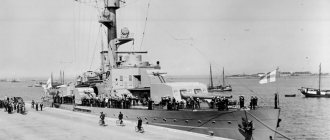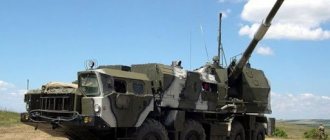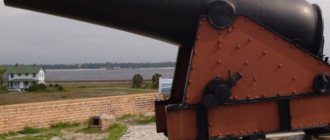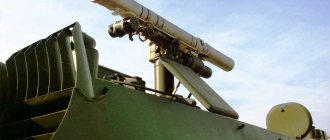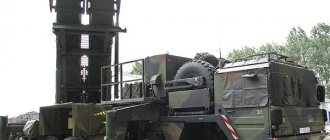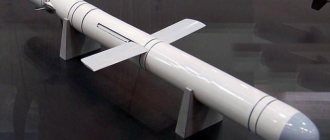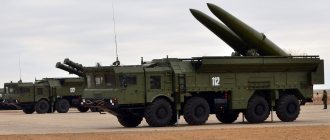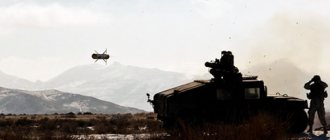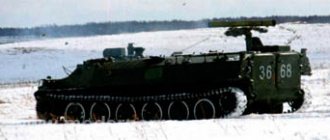One of the basic tasks of state defense is to protect the coast from enemy landing ships and aircraft. The emphasis is on the ability not only to quickly and effectively repel possible attacks, but also to regroup, deploying weapons in the right directions.
The second aspect is especially important due to the vast extent of the northern and eastern coasts of the country. Modern features of combat should also be taken into account, where timely detection of a target and its effective destruction play an important role.
Taking into account such aspects, priority is given to mobile ballistic missile systems that are capable of quickly occupying the desired position, achieving combat readiness in a matter of minutes and repelling attacks with quick and effective strikes, despite fire and radar.
What is DBK "Bastion"
DBK "Bastion" is a coastal missile system used to protect the coast from enemy ships. Designed to defeat any surface targets, including aircraft carriers and landing ships. Can act both against groups and against single targets.
DBK "Bastion" belongs to the fourth generation anti-ship missile systems. It shows excellent operational and combat characteristics, which is why it is in service with the Russian army. Depending on the deployment, stationary and mobile complexes are distinguished.
Launcher DBK "Bastion"
Purpose
Designed to destroy surface ships of various classes and types from amphibious formations, convoys, ship and aircraft carrier strike groups, as well as single ships and ground radio-contrast targets in conditions of intense fire and electronic countermeasures.
The Bastion ballistic missile launcher is one of the carriers of the Onyx missile, which, in turn, along with the Caliber and Kh-35 Uran missile systems and the promising Zircon hypersonic anti-ship missile, is the main anti-ship missile weapon in the Armed Forces Russia.
History of the creation and development of DBK "Bastion"
The history of the development of the Bastion DBK begins in the mid-80s of the last century. The main task assigned to the mechanical engineering industry was to replace the Rubezh and Redut coastal missile systems that were then in service.
The development of the new DBK was undertaken by the general designer Efremov. The initial project involved the creation of a universal operational-tactical crew. New anti-ship missiles could be placed not only on coastal fortifications, but also on ships and submarines.
The first tests of new rocket launchers took place in 1985. Two years later, launches were carried out from a surface ship. The first launch from a submarine was carried out in 1992.
Taking into account the difficult economic situation that developed in the country after the collapse of the USSR, the development of the Bastion DBK progressed at a slow pace. The last tests were completed only in 2002, along with the commissioning of the Onyx (Yakhont) anti-ship missiles.
In 2010, the Bastion DBK was adopted by the Russian army.
New systems entering service gradually include additional units for the guidance system. Based on them, the targeting accuracy is several meters, which gives the complex the ability to hit small objects on land with precision strikes.
Operating countries
In Russia, according to 2022 data, 40 sets of this equipment were adopted for service, located:
- in Crimea - in the cities of Anapa and Sevastopol;
- in the Pacific Fleet - in the Kuril Islands and Kamchatka;
- in the Northern Fleet - on Novaya Zemlya;
- in the Baltic - in the Kaliningrad district.
The full rearmament program with the transition to this type of coastal defense equipment is designed until 2022.
In addition to the Russian Federation, two Bastions were exported to Vietnam and Syria. Export deliveries continue. The possibility of exporting equipment to Venezuela is being discussed.
Important! “Bastion” is a Russian weapon that consistently receives high marks from experts based on demonstrations at military forums and ongoing shooting exercises.
Purpose of the Bastion system
The Bastion coastal missile system is designed for coastal defense and counteraction against enemy surface ships. The main focus is on landing and aircraft carrier groups, however, the installation can effectively deal with single targets, including support ships.
Despite the departure from its original versatility, the complex remains an effective weapon for hitting ground targets.
On November 16, 2016, such an attack was carried out during an operation in Syria. Such an incident was the first widely known in history, as well as the first use of the installation in real combat operations.
DBK "Bastion" at exercises on the defense of the Arctic coast
Exploitation
"Bastion" quickly appeared in the army. The first installations began to be transferred to missile and artillery brigades that are part of the Black Sea Fleet at the end of 2009. Already in 2014, the complex’s vehicles took part in the parade on Red Square. And not only there - on May 9, the K-300 was seen in Sevastopol. After the Crimean referendum on joining Russia, the peninsula became one of the main bases of the complex.
It is also planned to build stationary K-300S installations there (until now all Bastions have been mobile). For this purpose, a missile base known as “object 100” is being restored near Sevastopol.
The K-300 was also deployed in areas of operation of other fleets, not only the Black Sea. The Northern Fleet stationed them on Novaya Zemlya, the Pacific Fleet - on the Kuril Islands and Kamchatka. The “bastions” of the Baltic Fleet are located in Kaliningrad.
The complex managed to prove itself in battle, although it had to hit “non-core” targets.
Several Black Sea Bastions were transferred to Syria back in 2016, where they were used to shell terrorist camps. The missile guidance system was modernized for this purpose - after all, “up to a meter” accuracy is not required to hit ships.
Interestingly, deliveries of K-300 to the Syrian armed forces (with Yakhont missiles) began even earlier - in 2011. The system was also exported to Vietnam, and negotiations were held on supplies to Venezuela. According to some reports, Syria did not use its Bastions to defend its borders. It was reported that the Syrians secretly transported the K-300 to the Lebanese Islamist group Hezbollah.
Composition of the Bastion coastal missile system
Composition of DBK "Bastion":
- self-propelled launchers on the MZKT-7930 chassis, crew - 3 people;
- combat control vehicle on the KamAZ-43101 or MZKT-65273 chassis, crew - 4 people;
- anti-ship missiles K-310 "Onyx" ("Yakhont") in a transport and launch container;
- information technology interface equipment with the command center;
- automated combat control system;
- a set of technical maintenance equipment;
- transport-loading machine K342P;
- combat duty support vehicle;
- educational and training complex;
- helicopter target designation complex.
Depending on the combat mission, the complex includes a self-propelled over-the-horizon radar station "Monolit-B". The radar's task is to detect air and surface targets.
Onyx rockets
Performance characteristics of Onyx missiles
Onyx anti-ship missiles, known in the export version as Yakhont, were developed together with the Bastion ballistic missile system. The projectiles are specially designed to hit targets in conditions of strong radio-electronic and fire interaction.
Missiles can be launched either in single shots or in salvos. In the second case, the emphasis is on automated interaction, which allows warheads to interact and calculate a plan for hitting specified targets with the greatest efficiency.
Technical characteristics of Onyx missiles:
- target engagement range - up to 300 and 120 km with a combined and mixed trajectory, respectively;
- flight altitude - from 10 m to 15 km;
- speed - 750 m/s;
- trajectory - combined and low-altitude;
- inertial control system;
- weight at the territorial production complex - 3900 kg;
- aviation and ship launch weight - 2500 and 3000 kg, respectively;
- penetrating warhead, weight - up to 300 kg;
- service life - up to 10 years.
Onyx cruise missiles leave the factory in a transport and launch container, ready for launch.
The use of such charges provides the following advantages:
- high (over-the-horizon) range of destruction;
- homing intelligence - shoot and forget;
- high flight speed, complicating missile interception;
- a wide range of flight path combinations.
Onyx is universal in use, allowing you to launch missiles from both ground-based installations and ships. Both vertical and inclined positions are suitable for launching. From the launch, the missile can reach the desired height, lowering it to 10-15 meters before hitting the target.
Launching an anti-ship missile from a camouflaged self-propelled gun
Self-propelled launchers or K-380R combat control vehicle
The self-propelled missile launcher is based on the four-wheeled MZKT-7930 and has two launch containers. The total weight of the launcher is 41 tons. On paved roads it can reach speeds of up to 70-80 km/h. Power reserve is up to a thousand kilometers.
A similar chassis is used for the loading machine, and KamAZ modifications are also used.
It carries two containers and has a loading crane capable of lifting up to 6 tons.
The advantage of a complex based on launcher data is almost instantaneous deployment to full combat readiness - 3 minutes. The interval between salvos is 2.5 seconds.
Deployment scheme of the Bastion ballistic missile system
Device
The main element of the complex is, of course, rockets. “Onyx” is not the largest and most powerful Russian anti-ship missile (the P-1000 “Vulcan” is now like that), but in terms of versatility it can compete with the American “Harpoons” and “Tomahawks”. It is used on surface ships and submarines and can be launched from aircraft. Inconspicuous to radar, Onyx, thanks to its ramjet engine, travels the entire distance to the target at supersonic speed.
The range, depending on the flight path, ranges from 120 to 500 km.
The Onyx’s “ability” to perform evasive maneuvers also prevents it from being shot down. The homing head is also resistant to interference and is able to independently recognize targets by selecting an attack mode. The missile travels most of the way to the target under the control of an inertial guidance system, and the radar begins to recognize targets at ranges of up to 75 km.
Onyx launches are carried out by the K-300P Bastion-P mobile complex and the Bastion-S stationary complex (K-300S). The K-300P system missiles are placed in launch containers mounted on the chassis of an all-wheel drive eight-wheel tractor model MZKT-7930. The vehicle carries two missiles, which it fires at intervals of just over two seconds. According to the state, the division includes four launch vehicles, and the largest number of launch systems in the complex is 12.
Naturally, to ensure the normal functioning of the Bastion, it includes mobile command posts, loading vehicles and maintenance equipment. Bastion can be brought into combat readiness in just five minutes.
The K-300 is on duty for 24 hours - unless a combat duty support vehicle is assigned to it.
If there is such a vehicle, on board which there are household premises, “Bastion” can remain in position for a month. A helicopter is sometimes attached to a missile battery, providing target designation for launches at over-the-horizon ranges. In the future, it may be replaced by a UAV.
Export versions of Bastion are usually equipped with Yakhont anti-ship missiles - this is a variant of Onyx, distinguished, in particular, by a less powerful charge.
Performance characteristics of the Bastion coastal missile system
The Bastion coastal missile system has the following technical characteristics:
- 24 missiles on 12 launchers;
- interval between launches - 2.5 seconds;
- deployment time from traveling to combat position - 3-5 minutes;
- the height of the starting position above sea level is up to 3 thousand meters;
- the deployment interval is 30 km between the control vehicle and the launchers, 15 km between the launchers;
- taking into account the range of missiles, Bastion can protect up to 600 km of coastline.
The complex can remain on combat duty from one to five days without additional support.
The total service life is 10 years.
"Collective mind"
“Onyx” is not just a high-precision intelligent weapon operating on the “fire and forget” principle. These missiles also have a “collective intelligence.” They are most effective when launched in salvo. In flight, the Onyxes exchange information with each other and, based on an analysis of the composition of the ship group, distribute targets among themselves according to the principle, draw up an attack plan and tactics for its implementation. Some missiles can attack a target head-on, others can covertly fly around the ship and enter from the rear, and the approach time is selected so that an attack by several missiles is carried out simultaneously.
All that remains is to quote one more quote from Vladimir Putin from the film about Crimea: “No one has such weapons.”
Varieties of the Bastion complex
Despite the versatility of the Onyx missiles, the Bastion ballistic missile system has two main configurations - mobile and stationary. The first is designed for the rapid transfer of forces to a given point. Stationary ones are used on constant duty in coastal defense.
Bastion-P
Performance characteristics of mobile Bastions
The key feature of the mobile Bastion-P ballistic missile system is deployment mobility. The mobile complex allows you to quickly respond to emerging threats and strengthen coastal defenses as needed.
Bastion mobile complexes are manufactured using modern composite materials. Multilayer panels absorb radar signals. Such protection makes mobile ballistic missile systems less noticeable to enemy radars.
The advantages of mobile Bastions are expressed in the following aspects:
- choosing a firing position;
- high mobility and secrecy of payments;
- Compact and low maintenance.
The composition of mobile complexes may vary depending on the goals and assigned tasks. The DBK can be equipped with auxiliary vehicles to ensure combat duty, a target designation helicopter, and a radar. The number of launchers can also be increased as needed.
Bastion-S
Performance characteristics of stationary Bastions
Stationary Bastions are also manufactured using composite materials. Due to their static location, they can be detected by the enemy faster, however, they are better protected. Such complexes are used for constant control over the coast in the main strategic directions.
From the stationary Bastion-S missile launchers, missiles are launched from silo installations. The missiles' destruction radius is up to 300 km, which provides protection for 600 kilometers of the coast from landing ships.
Advantages of stationary DBK:
- high degree of protection;
- low requirements for combat crews;
- anti-ship missiles can be checked without being removed from their launchers.
Unlike mobile complexes, stationary ones are based on silo launchers and a control module. A protected command post, equipment that provides interface with installations and additional means that enhance the combat effectiveness of the complex are used.
Technical parameters and comparison with analogues
The American analogue of the K-300 complex can be considered modifications of the Harpoon missiles launched from mobile installations. The United States itself does not use them - since the beginning of the Cold War, American shores were planned to be protected mainly from strategic aviation.
It was she who was seen as the main threat, and therefore the coastal batteries included mainly anti-aircraft missiles. The development of mobile anti-ship missile launchers was carried out by countries that were counting on a collision with significant enemy naval forces. For example, Japan and Taiwan.
| "Onyx" | Type 12 | Xiongfeng 3 | RGM-84N Harpoon | |
| Rocket mass, tons | 3 | 0,7 | 1,3 | 0,6 |
| Rocket length, meters | 8 | 5 | 6 | 4,6 |
| Launch range, km | Launch range, km | 200 | 150 | 280 |
The missiles used for comparison are similar in design to the control system - an inertial guidance system, with an active radar seeker that turns on at the final part of the trajectory and the ability to correct the course using satellite navigation.
Japanese and Taiwanese models, designed to withstand the Chinese fleet, have a relatively short range. American “Harpoons”, despite the constant improvement of guidance systems, are already old weapons and noticeably inferior to “Onyx” in range, speed and warhead weight. So there is nothing surprising in the fact that “Bastion” has aroused interest on the international market.
"Bastion" was a great success for Russian designers.
They managed to replace aging coastal systems with new, modern weapons that will retain their combat qualities for a long time.
It also evokes respect that the adoption of the K-300 by the troops occurred in the years when almost any model of new Russian military equipment was met primarily with doubts about the possibility of its launch into series. But with the increase in the number of “Bastions”, there is no doubt that the sea borders will be reliably covered.
Differences between Bastion complexes
Apart from the obvious differences between stationary and mobile deployment, Bastion-S and Bastion-P do not have significant differences in combat characteristics. The complexes have similar technical indicators in terms of readiness for combat and firing.
The difference is in the protective properties of the Bastions. Stationary systems focus on the protection of mine installations and the difficulty of their destruction. For mobile DBKs, the main emphasis is on mobility and difficulty of detection.
Differences between the complexes are also distinguished in the tasks assigned. Stationary ones are focused on the permanent defense of certain areas of the coast. Mobile systems make it possible to solve operational problems, as well as participate in military operations outside the country.
How successful was this development? Write your opinion in the comments with links to known analogs and application possibilities.
Supersonic speed
The maximum speed of Onyx is 2.6 times the speed of sound (750 m/s). This, firstly, makes it extremely difficult to intercept a missile by air defense systems due to the short flight time, and secondly, it reduces the requirements for the accuracy of the external target designation system. The ship simply does not have time to sail far in the few minutes that the rocket is in the air.
A ramjet engine (ramjet) allows Onyx to achieve such high speeds. Unlike a conventional turbojet engine, it has no rotating parts - a turbine and a compressor, which ensures high reliability and efficiency at high speeds. It is precisely this engine that will be used on promising hypersonic missiles, which are currently being developed by NPO Mashinostroyeniye.
Description of the rocket
The Bastion complex is equipped with the Onyx missile, designed to destroy enemy surface targets with single salvoes or massive fire in the event of large-scale electronic interference and enemy fire confrontation. The maximum range is three hundred kilometers.
The basis for the development of the rocket was the classic version of the design, which assumed a cruciform outline of the surface of the body, providing high aerodynamic qualities. The layout is made with the homing head, the main equipment of the control circuit and the warhead placed in the center of the air intake.
The rocket is 8.2 meters long and weighs three tons. The use of a ramjet engine with a solid fuel primary accelerator ensures Onyx acceleration to seven hundred and fifty meters per second. Kerosene is used as liquid fuel.
If a warhead is launched from under water, the air intake is covered with a fairing that fires off after entering the atmosphere.
The work of the accelerator begins immediately after the rocket leaves the launch silo. After it has been worked out, further acceleration is carried out by the main engine, with the help of which the maximum speed is gained. Delivery of the missile to the target location is ensured by an inertial navigation aid. After this, the object is preliminarily captured by the homing head. Subsequently, the missile moves at a minimum altitude (up to fifteen meters), remaining inaccessible to enemy air defense systems. Finally, the radar is launched again, tracking the specified target.
On a note! The launched warhead does not require additional escort. It operates autonomously and does not require personnel supervision after startup.
Onyx missiles of the Bastion system are launched in single or salvo mode to destroy a group of objects. In this case, the missiles move together, adjusting the distribution of targets and determining the most successful option for destruction. Additionally, the missiles are equipped with a computing system that ensures the effectiveness of the attack in conditions of exposure to electronic interference and air defense systems.
“Onyx” is distinguished by the following characteristic features:
- the ability to hit targets located beyond the horizon due to its high flight range;
- high speed of movement, making it extremely difficult for the enemy to counteract it;
- high intelligence, with a “fire and forget” principle;
- variability of delivery to the object with changes in the flight path;
- low altitude when approaching the target;
- universality of use on various delivery and launch vehicles;
- high maneuverability and good aerodynamic properties;
- Possibility of use for group launches simultaneously on several objects.
Onyx is produced in two versions:
- 3M55 - basic, main working version;
- 3M55E - products for export.
Options differ in maximum flight range.
The product leaves the factory packaged in a special container for transportation and launch, which allows it to be fired at any time. It is possible to check and diagnose equipment without removing the charge from the container. For launching, an inclined or vertical launch shaft is used.
On a note! Depending on the conditions of use, the container is made cylindrical (for use in the fleet and in coastal systems) or suspended aviation, used on aircraft.
Modifications
The system is produced in two modifications:
- Bastion-P (designation K300P) - mobile version;
- Bastion-S (marking K 300S) is a stationary complex.
For the mobile modification of the Bastion rocket launcher, the MZKT-7930 chassis is used, the stationary model is located in the shaft.
K 300 Bastion
